Sands are usually sheared under drained conditions as they have relatively higher permeability. This behaviour can be investigated in direct shear or triaxial tests. The two most important parameters governing their behaviour are the relative density (ID) and the magnitude of the effective stress (s¢). The relative density is usually defined in percentage as
![]()
where emax and emin are the maximum and minimum void ratios that can be determined from standard tests in the laboratory, and e is the current void ratio. This expression can be re-written in terms of dry density as

where gdmax and gdmin are the maximum and minimum dry densities, and gd is the current dry density. Sand is generally referred to as dense if ID > 65% and loose if < 35%.
The influence of relative density on the behaviour of saturated sand can be seen from the plots of CD tests performed at the same effective confining stress. There would be no induced pore water pressures existing in the samples.

For the dense sand sample, the deviator stress reaches a peak at a low value of axial strain and then drops down, whereas for the loose sand sample, the deviator stress builds up gradually with axial strain. The behaviour of the medium sample is in between. The following observations can be made:
• All samples approach the same ultimate conditions of shear stress and void ratio, irrespective of the initial density. The denser sample attains higher peak angle of shearing resistance in between.
• Initially dense samples expand or dilate when sheared, and initially loose samples compress.